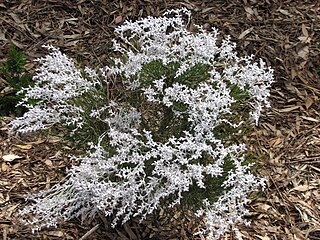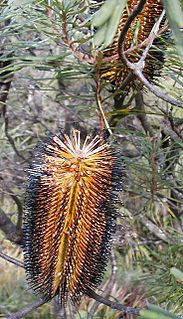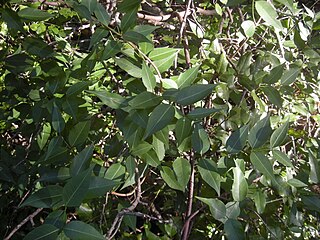
Grevillea miniata, commonly known as the sandstone grevillea, is a shrub or small tree between 1.8 and 5 metres in height which is native to Western Australia and the Northern Territory. It has yellow or orange flowers and holly-like leaves.

Ventilago viminalis, commonly known as supplejack, vine tree or whip vine, is a tree native to Northern and Central Australia from coastal regions of Queensland to the Northern Territory and Western Australia.

Conospermum stoechadis, commonly known as common smokebush, is a shrub endemic to Western Australia.

Banksia spinulosa var. cunninghamii, sometimes given species rank as Banksia cunninghamii, is a shrub that grows along the east coast of Australia, in Victoria and New South Wales. It is a fast-growing non-lignotuberous shrub or small tree infrequently cultivated.
Plantago debilis is a species of herb native to Australia. Common names include shade plantain and weak plantain.
Stemona australiana is a plant species native to tropical south-east Asia, including northern Australia and Papua New Guinea. It grows as a herb or climber up to two metres high.

Grevillea pteridifolia is a species of Grevillea native to Australia. Common names include silky grevillea, Darwin silky oak, ferny-leaved silky oak, fern-leaved grevillea, golden grevillea, golden tree and golden parrot tree. It occurs in Western Australia, Northern Territory, and Queensland.

Adenanthos × cunninghamii, commonly known as woollybush, Albany woollybush or prostrate woollybush, is a hybrid shrub in the family Proteaceae. It is endemic to the south-west of Western Australia.

Randia moorei, commonly known as the spiny gardenia, is a rare Australian shrub growing in the far north eastern areas of the state of New South Wales and adjacent areas in Queensland. The habitat is subtropical rainforest north of Lismore.

Gmelina fasciculiflora, known as the northern white beech is a species of trees endemic to the Queensland tropical rain forests, Australia, of the mint (Lamiaceae) plant family. It is one of four recognised species of the genus Gmelina found in Australia.

Adenanthos sect. Eurylaema is a taxonomic section of the flowering plant genus Adenanthos (Proteaceae). It comprises four species, all of which are endemic to southwest Western Australia.

Persoonia falcata, commonly known as the wild pear, is a shrub native to northern Australia.

Gymnanthera is a genus of vines in the family Apocynaceae, first described as a genus in 1810. It is native to China, Southeast Asia, and Australia.
- Gymnanthera cunninghamii(Benth.) P.I.Forst. - Enderby Island + Dampier Archipelago of Western Australia
- Gymnanthera oblonga(Burm.f.) P.S.Green - S China, Cambodia, Indonesia, Malaysia, New Guinea, Philippines, Thailand, Vietnam; Australia

Lomatia arborescens, commonly known as smooth lomatia or tree lomatia, is a shrub or small tree that grows at high altitudes, in and near rainforests. It is found north from the Barrington Tops area in eastern Australia.

Hardenbergia comptoniana is a species of flowering plant in the pea family, Fabaceae, native to Western Australia. A twining vine, it produces purple flowers in the Southern Hemisphere spring. It is found on sand dunes and sand plains, and in open forest, on sand- or clay-based soils. It is readily cultivated in the garden, where it does best in a part-shaded position.

Corymbia grandifolia, commonly known as the cabbage gum, large-leaved cabbage gum and the paper-fruited bloodwood, is a species of tree that is endemic to northern Australia. It has smooth bark, egg-shaped to broadly elliptic to lance-shaped adult leaves, flowers buds in groups of three or seven, creamy white flowers and cup-shaped to cylindrical fruit.
Terminalia grandiflora, commonly known as yalu, plumwood or nutwood, is a tree of the family Combretaceae native to northern Australia. The Nungali and Jaru peoples know the tree as badgari and the Wagiman know it as barnyin.

Lysiana subfalcata, common name Northern mistletoe, is a spreading to pendulous hemi-parasitic shrub in the Loranthaceae which occurs in all mainland states of Australia except Victoria.

Acacia latescens, also known as Ball wattle, is a tree in the genus Acacia. It is native to the Northern Territory where it is common in the Top End.

Tribulus platypterus, the cork hopbush, is a species of flowering plant in the family Zygophyllaceae, which is endemic to the northwest of Western Australia. It is closely related to Tribulus suberosus.




















